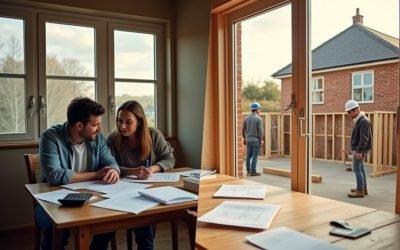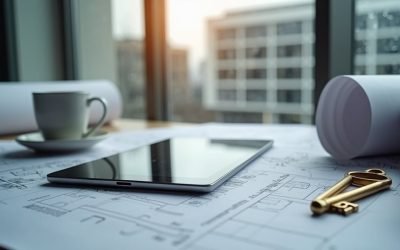Diving into the sea of house refurbishment can feel like navigating uncharted waters, especially when it comes to cost. You’re about to embark on a journey that will transform your house into your dream home. But what’s the damage to your wallet?
This guide will shine a light on different aspects of refurbishment costs, from the strip-out stage to the all-important heating system. We’ll analyze the cost of each element, helping you understand the financial landscape you’re venturing into.
With careful planning and informed decisions, you can ensure your refurbishment project doesn’t break the bank.
Key Takeaways
- The cost of a furniture strip out is approximately £2,000, while a back to brick strip out can range from £3,000 to £12,000.
- The configuration of the property, including the removal of walls or chimney breasts, can impact the overall cost of the refurbishment, and additional costs may be incurred for structural changes.
- A full rewire with a new fuse board, spotlights, and sockets can cost around £42,000, and it is important to ensure compliance with electrical safety regulations.
- Installing a new central heating system, including a boiler and radiators, can cost approximately £45,000, and factors such as aesthetics and energy efficiency should be considered when choosing heating options.
Strip Out Costs
When you’re starting your house refurbishment, the first cost you’ll encounter is for the strip out, which can be either furniture removal or a back to brick strip out. The strip out alternatives depend on your project’s scope and your budget.
For furniture removal, you’re likely looking at around £2,000. If you opt for a back to brick strip out, which involves more extensive work such as removing kitchen and bathroom fittings and carpentry, the cost can go from £3,000 to £12,000.
It’s essential to have a detailed strip out cost breakdown from your contractor to avoid hidden expenses. Furthermore, consider the configurations of your property. Removing walls or chimney breasts can add to your costs, but it may improve your home’s layout and functionality.
Property Configuration Expenses
You’ll need to account for the costs associated with the configuration of your property, which can vary depending on structural changes like the removal of walls or chimney breasts. Understanding these costs is crucial in the planning phase, particularly when it comes to the property layout.
Here’s a table to help you visualize potential expenses:
| Property Configuration | Description | Estimated Cost |
|---|---|---|
| Removing Walls | Could be crucial for a more open layout | Variable |
| Chimney Removal | Important for space utilization | Variable |
| Structural Changes | May include altering load-bearing walls | Variable |
| Professional Consultation | Necessary for accurate pricing | Variable |
Each configuration change will have its own cost, depending on the complexity of the work and your region’s labour rates. Always consult with professionals for accurate pricing.
Rewire and Electrical Costs
One significant cost you can’t ignore in your house refurbishment is the rewire and electrical work. This typically runs around £42,000 for a full rewire that includes a new fuse board, spotlights, and sockets.
Your negotiating options can play a significant role in managing these costs. Consider the following details:
- Full rewire: This includes updating all electrical wiring, switches, sockets and adding a new fuse board.
- Partial rewire: If you’re on a budget, you might opt for a partial rewire.
Remember, compliance regulations are crucial. So, ensure your contractor adheres to:
- Building Regulations: These cover the basic design and construction details.
- Electrical Safety Standards: Your electrical installations must meet the UK national standard, BS 7671.
Stay informed to make smart decisions.
Central Heating Installation
Investing in a new central heating system is a crucial aspect of your house refurbishment. The cost for this typically hovers around £45,000. This investment promotes central heating efficiency, ensuring a warm and comfortable living space for you and your family.
The cost not only covers the new boiler, but also includes radiator placement, which plays a pivotal role in maximizing the heat distribution in each room. You should consider professional advice for optimal positioning.
It’s also important to factor in the type of boiler and radiators, as these can significantly impact the overall efficiency of your central heating system. A highly efficient system can reduce energy consumption, subsequently lowering your bills. So, while the upfront cost may seem high, the long-term savings can be substantial.
Plastering Prices
When it comes to plastering your house, it’s important to understand that the costs can vary depending on the method you choose. Two common methods are skimming and back to brick plastering.
- Skimming: This is a cost-effective method, ideal when your walls are in good condition. It involves applying a thin layer of plaster to create a smooth surface. Costs usually range around £5,000.
- Back to brick: If your walls are severely damaged, you might need to resort to back to brick plastering which involves reboarding and plastering. This method is pricier, around £7,000.
Factors affecting plastering costs include the condition of your walls, the area to be plastered, and the plastering method chosen. Always seek multiple quotes to ensure you’re getting a fair price.
Considerations for Refurbishing
As you plan your house refurbishment, it’s crucial to consider factors beyond cost, such as the impact on the property’s layout, the aesthetics, and ensuring compliance with safety regulations. Budget planning is key, and a decision between DIY versus hiring professionals can significantly affect your costs.
| Consideration | DIY | Professionals |
|---|---|---|
| Budget Planning | Cheaper, but requires more time and effort | More expensive, but better quality and faster |
| Impact on Layout | Limited by your skills | Professionals can optimize layout |
| Aesthetics | Depends on your abilities | Professionals ensure high-quality finish |
| Regulatory Compliance | Risk of non-compliance | Professionals know the regulations |
Unexpected Renovation Costs
You should also factor in the potential for unexpected renovation costs, which can significantly impact your budget. These hidden expenses often come as a surprise, but with some foresight and budgeting tips, you can prepare for them. Here are a few to consider:
- Structural Issues:
- Foundation repairs
- Roof replacement
- Pest infestations
- Regulatory Requirements:
- Updating outdated wiring
- Installing necessary safety systems
Structural issues can suddenly arise during renovation, and often, they’re not optional fixes. Likewise, meeting regulatory requirements can add a pretty penny to your expenditures, especially in older homes.
Frequently Asked Questions
What Are Some Common Mistakes to Avoid While Refurbishing a House?
Avoiding common refurbishment errors, like neglecting hidden costs or skimping on quality materials, is crucial. You’ll prevent unnecessary expenses and ensure your home’s longevity by meticulously planning and investing in high-quality resources.
How Long Does a Typical House Refurbishment Process Take?
Your refurbishment timeline largely depends on your contractor selection, house size, and project complexity. It can take several weeks to a few months. Plan carefully and anticipate delays to ensure a smooth refurbishment journey.
Can I Live in My House During the Refurbishment Process?
You can live in your house during refurbishment, but consider relocation options for comfort. Safety measures are essential to protect against dust, noise, and potential hazards. It’s about balance – convenience versus disruption.
How Can I Save Money When Refurbishing My House?
You can save money refurbishing your house by employing DIY refurbishing techniques for tasks you’re confident with. Implementing strict budgeting techniques also helps prevent overspending. Always remember, planning and research are key.
What Are the Potential Environmental Impacts of a House Refurbishment?
Refurbishing your house can impact the environment through waste generation and energy consumption. However, using sustainable materials and opting for green renovations can significantly reduce these impacts, making your project more eco-friendly.
Final Thoughts
Refurbishing a house is a significant investment, and costs can vary widely. From strip outs to rewiring, heating installation, and plastering, it’s crucial to budget wisely.
Don’t forget to factor in unexpected renovation expenses and ensure safety compliance. With careful planning, clear expectations, and smart negotiations, you can create your dream home without breaking the bank.
Remember, every penny spent is a step towards enhancing your living space.


